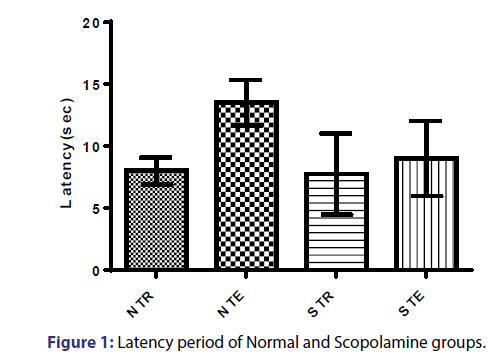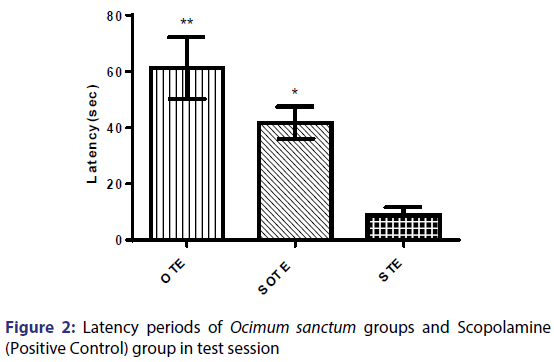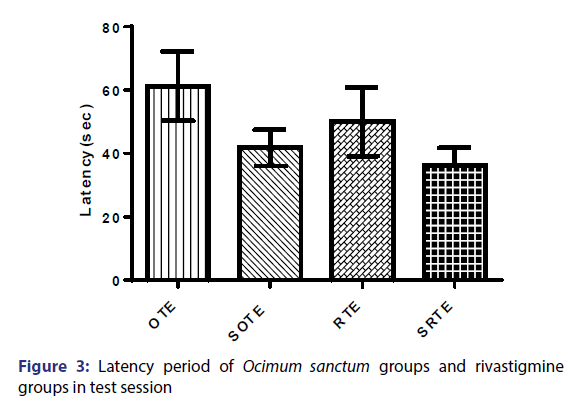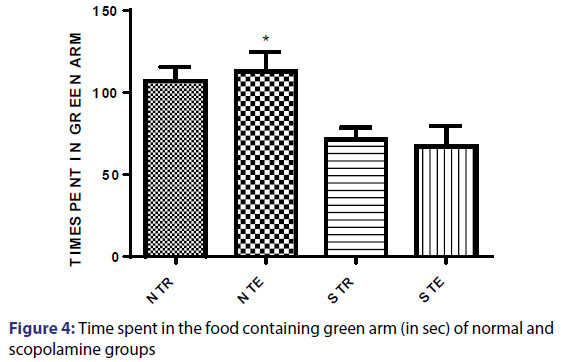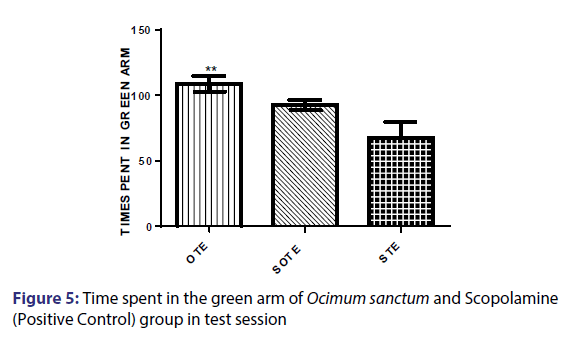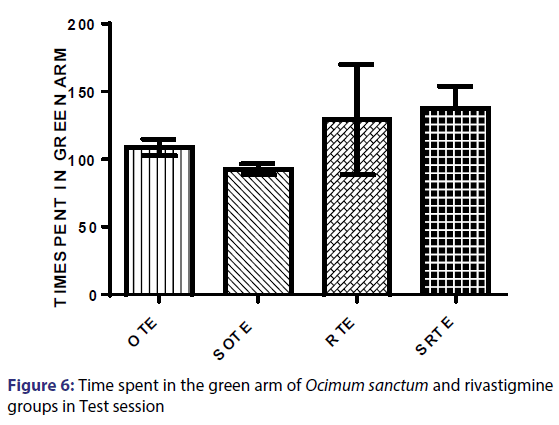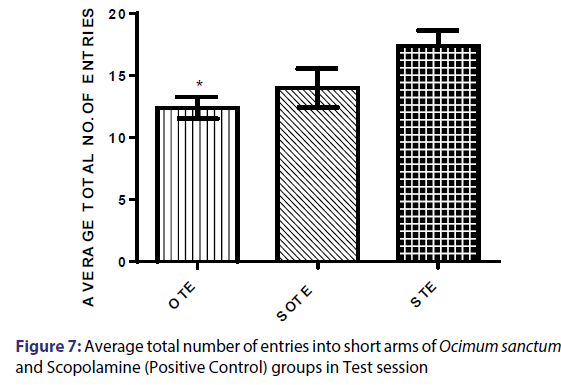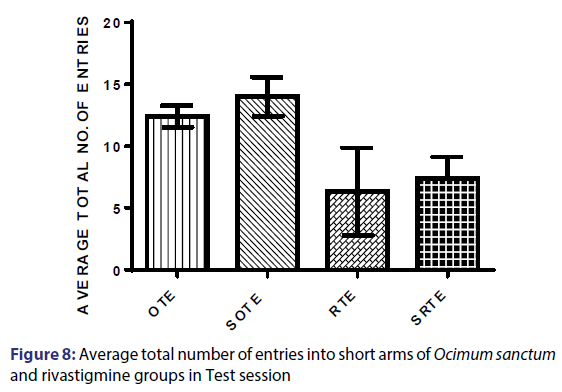Assessment of Aqueous Extract of Ocimum sanctum Leaves in Memory Enhancement and Preventing Memory Impairment Activities in Zebra Fish Model
- *Corresponding Author:
- Karthik Maddula
Department of Pharmacology, Bharat Institute of Technology, Hyderabad, India
E-mail: karthikmaddula@gmail.com
This is an open access article distributed under the terms of the Creative Commons Attribution-NonCommercial-ShareAlike 3.0 License, which allows others to remix, tweak, and build upon the work non-commercially, as long as the author is credited and the new creations are licensed under the identical terms.
Abstract
Objective: In the present study, effect of Ocimum sanctum leaves aqueous extract on the memory impairment and memory enhancing activity in zebrafish is studied using rivastigmine as the standard drug and scopolamine as the memory impairing agent. Methods: Zebrafishes were procured from local aquarium store, aqueous extract of Ocimum sanctum leaves was used as a test drug whereas rivastigmine as a standard drug. Scopolamine was used to induce memory impairment. Two behavioral tests, namely, Inhibitory Avoidance Test and color bias avoided with appetite conditioning T-Maze test were employed for evaluating the memory impairment and memory enhancement activity. Latency is the parameter measured in Inhibitory Avoidance Test whereas Time spent in the food containing green arm and average total number of entries into short arms were the parameters evaluated in T maze test. Results: The latency period of (SOTE) Ocimum sanctum pre-treated scopolamine group was found to be 42 sec whereas 9 sec in (STE) scopolamine alone treated group. The time spent in green arm by the former group was found to be 93 sec whereas 67 sec by latter group. The average total number of entries into short arms by former group was 14 whereas 17 by the latter group. Conclusion: The results of the present study contribute to the ability of OS leaves extract in ameliorating the memory impairment effects of scopolamine and can be used as a potential drug for neurodenegerative diseases like Alzheimer’s Disease.
Keywords
Zebra fish, scopolamine, rivastigmine, Ocimum sanctum, inhibitory avoidance test, t-maze test, alzheimer’s disease
Introduction
Alzheimer’s Disease is a neurodegenerative disorder which is characterized by progressive loss of memory and can also include motor disability, hallucinations, speech impairment depression, delusion and progressive behavioral disturbances through the disease course. The major pathophysiological hallmarks of AD are Neurofibrillary tangles and Amyloid β Plaques. Depletion of Acetylcholine, excitotoxicity due to elevated glutamatergic transmission, oxidative stress and chronic inflammation due to damaged neurons are also pathophysiological factors for AD.[1] The global prevalence of Alzheimer’s disease in Europe is 4.4%, 9.7% in US and 3.4% in developing countries like India. GlobalData’s report forecasts that approximately 12.5 million people are living with Alzheimer’s disease across 9 major countries that include India. This Figure 1 is expected to increase by 33.5% over the next decade to a total of 16.7 million cases in 2022. GlobalData believe that highest number of prevalent cases of Alzheimer’s Disease while India will demonstrate the fastest growth rate.[2]
Degeneration of neurons occur during the disease progression in the brain regions which play a vital in learning and memory like hippocampus, frontal cortex, inferior parietal cortex and basal forebrain. The two main pathological hallmarks of the disease are the occurrence of amyloid beta plaques and intracellular aggregates of microtubule associated protein called tau forming neurofibrillary tangles.[3] Apart from these histopathological hallmarks, another most accepted theory is cholinergic hypothesis. According to this theory, there is a deficiency of cholinergic neurons extending from nucleus basalis magnocellularis of Meynert to the cortex and hippocampus. There is a reduction in the depolarization induced acetylcholine release and choline uptake into the presynaptic neuron. The decrease in the activity of the enzyme, a reliable marker of cholinergic neurons and synapses, Choline acetyltransferase, responsible for the synthesis of acetylcholine was also found.[4] Nevertheless the many concepts of Alzheimer’s disease, cholinomimetics were found to be potential drugs for the symptomatic treatment of Alzheimer’s disease. The approved cholinomimetic drugs commonly prescribed for the Alzheimer’s disease patient were Rivastigmine, Donepezil, Tacrine.[5] The present study is based on this theory where the test drug employed in this study was acetylcholinesterase inhibitor.
Currently, researchers and scientists are looking forward for research on medicinal plants for the potential treatment of many diseases believing that they have very fewer side effects and found to be economical. [6] Ocimum santum, employed in the present study, is also known as Ocimum tenuiflorum commonly called as Tulasi which is a queen of herbs, is considered as the holy plant and respected among all the healing and healthy giving herbs. The stem and leaves of the plant have variety of chemical constituents like saponins, flavonoids, triterpenoids, and tannins. Ocimum sanctum had been used traditionally in Ayurveda and siddha for the treatment of many illnesses.[7]
The wide variety of animals from Caenortabitidis elegans to non-human primates were under use as models for carrying out preclinical studies to study the complex biological processes, morphological, behavioral and neurophysiological aspects of aging.[8] Among all the animals that are under existence, the most popular, classical, commonly used animal model is rodent model, which includes rats and mice. But recently, another model, Zebrafish model seized the attention of the researchers as a model for behavioral neuroscience.[9] In addition to the behavioral studies, many other studies can be performed in zebra fish like teratogenicity, Cardiovascular, Hyperlipidemic, mutagenicity studies. The beneficial factors that render zebra fish as the successful animal model are fully characterized genome,[10] similar neuronal connections in the brain, physiology similar to mammals, longer lifetime, high reproductive rate, external fertilization and the key convincing factor for its usage in the color discrimination involved behavioral analysis is that anatomy and physiology of zebra fish retina is similar to that of the vertebrates including humans.[11] In the present study, we have evaluated the aqueous extract of Ocimum sanctum leaves in preventing memory impairment using zebra fish model. The rationale of the present study is to evaluate the aqueous extract of Ocimum sanctum leaves in preventing memory impairment using zebra fish model and also to prove that zebra fish model can also be used as the preclinical model for the pharmacological screening of drugs.
Materials and Methods
Experimental animals
Adult Male Zebra Fishes were procured from a local aquarium pet store. Animals were kept in housing tanks with the RO treated water at a density of 5 animals per 3 litres. Animals are kept at 14-10h light and dark photoperiod and are continuously aerated. Animals were fed with pellets (contains crude proteins, crude fat, crude fiber) obtained from the pet store. Animals were acclimatized to the laboratory conditions for about 10 days before the commencement of the experiment.
Plant material collection
The leaves of the plant, Ocimum sanctum (Ocimum tenuiflorum L) were collected from Mehdipatnam (Hyderabad, Andhra Pradesh) and authenticated by concerned expert in Botanical Survey of India, Deccan Regional Center, Hyderabad.
Preparation of extracts
The leaves of the Ocimum sanctum were collected, separated, dried in shade and powdered coarsely with a blender. Maceration is the technique used for carrying out the extraction using water as a solvent. Extraction was carried out for 7 days with occasional stirring. On the 8th day, the filtrate is collected and solvent was removed by boiling on water bath. The dried extract was collected and kept in air tight container.
Chemicals
Scopolamine (Gift sample from IICT, Hyderabad, Andhra Pradesh, India) and Rivastigmine (RIVAMER capsules Marketed by Sun Pharma were used).
Equipment’s
1. Aquarium: A Glass aquarium of dimensions 30 cm × 15 cm × 15 cm was used for housing zebra fishes at a density of 5 fishes per 3 liters.
2. Aerator: Aerators of Sobo aquarium air pump-SB-548A were used for supplying air into the water in order to make the fishes stay alive.
3. Animal Feed: Zebra fishes were fed with dry food which was regularly provided in the aquarium pet shop. The dry food contains crude protein (30%), crude fat (4%), crude fiber (5%), crude ash (12%), moisture (10%).
4. Micro Pippete: 10 μL and 100 μL capacity micropipettes of Thermoscientific Finnpipette Company were used during the study.
5. Passive Avoidance Test Apparatus:
An aquarium of dimensions 18 cmx9 cmx7 cm was prepared using acrylic glass sheet. A sliding partition was made in middle of the aquarium.
Passive avoidance test apparatus
T maze test apparatus
A T-Shaped maze was prepared using acrylic glass sheet of dimensions 50 cmx10 cmx10 cm long arm and 2 short arms of dimensions 20 cmx10 cmx10 cm. A start box of 10 cmx10 cmx10 cm was prepared in the long arm.
T-Maze Test
Experimental Design
Adult Zebra fishes of 0.5 g weight are randomly divided into six groups with five animals in each group. All the animals were separated into different groups in housing tanks and kept for acclimatization in the laboratory for 10 days. Memory impairment was induced by using Scopolamine of 200 μM where fishes were transferred into the tank containing 200 μM scopolamine solutions.
Group I: Scopolamine (200 μM)
Group II: Standard Rivastigmine (1.5 mg/kg) dissolved in water [p.o]+Scopolamine (200 μM)
Group III: Test Ocimum sanctum leaves extract (500 mg/kg) dissolved in water [p.o]+Scopolamine (200 μM)
Group IV/A: Water only
Group V/B: Standard Rivastigmine (1.5 mg/kg) dissolved in water [p.o]+zater
Group VI/C: Test Ocimum sanctum leaves extract (500 mg/kg) dissolved in water [p.o]+Water
Animal Procedures
Dose of the aqueous extract was chosen based on the previous work done on rodents.[12] According to the study conducted on rodents Ocimum sanctum aqueous extract (500 mg/kg) significantly decreased the Acetylcholinesterase activity and improved cognition. The above dose 500 mg/kg is adjusted to the weight of zebrafish and was administered orally using 1-10 μL Micropipette. Standard drug used in the present study was Rivastigmine, which is an Acetylcholiesterase Inhibitor, currently used in the market for treating patients with Alzheimer’s disease. Water is used as a vehicle; both standard drug and Ocimum aqueous extract were dissolved/suspended in the water. Before 2 hours of the commencement of the experiment, standard Rivastigmine and test drug Ocimum extract were administered to the animals and 1 hour before the commencement of the experiment zebra fishes were treated with scopolamine. 200 μM solution of Scopolamine was prepared and animals were transferred to the tank containing the scopolamine solution before 1 hour of beginning of the experiment. Standard and test drug solutions were prepared freshly on the day of the experiment.
Experimental Procedures
In the present study, to evaluate the disease symptoms 2 behavioural tests were performed.
1. Inhibitory Avoidance Test and
2. T-maze test.
Inhibitory Avoidance Test
Apparatus
An aquarium of dimensions 18 cm × 9 cm × 7 cm was prepared using acrylic glass especially for performing this evaluation test. This tank was divided in to 2 equal white and dark compartments by a sliding door (9 cm × 7 cm). Dark compartment was made by covering the three sides of the tank with the black sheet. Tank was filled with water level up to 3 cm and sliding partition was raised 1 cm above the floor to allow the fishes move freely from one compartment to other. In the dark compartment, two electrodes were kept extending the tank height in the two corners of tank and 3mA current was applied.
Experimental procedure
Inhibitory Avoidance Test consists of training session and test session. In the training session, animals were allowed to learn a condition and in the test session, animals were evaluated for their memory.
Training session
In the training session, animals were kept in the white compartment while the partition is closed. After 1 minute, the partition was raised 1 cm above the tank floor and fish was allowed to enter the dark compartment. After the entry of fish in to dark compartment (with its whole body inside the compartment) sliding door was closed and then a current shock of 3 mA was applied for 2 or 3 seconds. Fish was then removed from the apparatus and transferred to the housing tank. This procedure was followed to train all the fishes. Before two hours of beginning of the training session, standard and test drug were administered and 1 h before the training, fishes were treated with 200 μM scopolamine solution.
Test session
After 24 hours of the training session, animals were tested.
In the test session, the same procedure as in training session was followed expect the shock of 3mA was not applied. Fishes were removed immediately after their entry into the dark compartment.
Parameters to be evaluated
1. Latency to enter the dark compartment was measured in both training and test sessions.
2. Colour Biased Appetite Conditioning T-Maze Test:
Apparatus
T Maze apparatus was prepared using transparent acrylic glass sheet. Dimensions of the maze were long arm of 50 cmx10 cmx10 cm and two short arms of 20 cm × 10 cm × 10 cm and start box of 10 cmx10 cmx10 cm at the foot of the stem.[13] The two short arms, left and right arms are covered with green and red coloured sleeves respectively. Water in the maze was filled up to 6 cm height and temperature of water was maintained at 28oC throughout the experiment.
Experimental Procedure
Training session
Initially, animals were placed in the T Maze without any coloured sleeves to habituate the animals before beginning of the experiment.
This evaluation test consists of training and test sessions. Training session was carried out for 6 consecutive days and the following day is test session i.e., on 7th day. In the training session, food was placed in green arm before beginning the experiment. The overnight fasted animal is placed in the start box for 1 minute. Then, sliding door was opened and closed after the exit of fish. Fish was then allowed to enter the short arms, once it entered any of the arms, another sliding door at the junction of the long arm and two short arms was closed. Now, fish was allowed to swim and observed for 4 minutes in the short arms. The total number of entries into the short arms and the time spent in the green arm were evaluated.[14]
Test session
After 6 days of training, on 7th day, the test session was carried out with the same procedure as that of training session by depriving food in the green arm.
Parameters to be evaluated:
Both in training session and test session, the following parameters are evaluated
1. Total No. of entries.
2. Time spent in Green arm.
Statistical methods
All the statistical analysis was done using Graph pad prism software and data were analyzed using One-Way ANOVA and data were presented as Mean ± SEM. Latencies of multiple groups were compared using Dunnet’s Multiple comparison test.
Results and Discussion
Results
Zebra fish were evaluated for learning and memory using Inhibitory avoidance test and T-Maze test. In Inhibitory Avoidance Test, latency period (in seconds) to cross the aperture of 1 cm into dark compartment was noted. Latency time of training and test session were compared to find differences between them. In case of T-Maze, time spent in the food containing green arm and average total number of entries into short arms are noted.
Results of inhibitory avoidance test
Comparison of Normal and Scopolamine group in Training (TR) and Test (TE) sessions using Latency as a parameter. The comparison of latency periods of Normal (Only water treated) and Scopolamine groups [Figure 1] in training and test sessions was carried out for demonstrating the effectiveness of scopolamine in memory impairment. The training session latency periods of only scopolamine treated group (STR) was found to be 7.8 sec whereas normal group (NTR) was found to be 8 sec. The test session latency period of only scopolamine treated group (STE) was found to be 9 sec whereas normal group (NTE) was found to be 14 sec [Table 1].
| S.no. | Groups | Latency | Mean | Mean ± Sem |
|---|---|---|---|---|
| 1. | NTR | 5 | 8.0 | 8.0 ± 1.1 |
| 9 | ||||
| 8 | ||||
| 10 | ||||
| 2 | NTE | 8 | 14 | 14 ± 1.8 |
| 15 | ||||
| 16 | ||||
| 15 | ||||
| 3 | STR | 16 | 7.8 | 7.8 ± 3.3 |
| 3 | ||||
| 2 | ||||
| 10 | ||||
| 4 | STE | 3 | 9.0 | 9.0 ± 3.028 |
| 5 | ||||
| 16 | ||||
| 12 |
Table 1: The Latency periods of Normal (Water only) and only scopolamine treated groups were assessed. The average latency periods (rounded off to nearest whole number) and SEM was calculated
Effect of Ocimum sanctum leaves extract on memory impairment by Scopolamine in test (TE) session using Latency as a parameter
In order to assess the effectiveness of Ocimum sanctum leaves extract, comparison of Ocimum sanctum groups (OTE and SOTE) with only scopolamine treated group (STE) was carried out [Figure 2]. The latency period of Ocimum sanctum groups, OTE and SOTE were found to be 61 sec and 42 sec respectively. On the other hand, the latency period of STE was found to be 9 sec. (Mean ± SEM of SOTE 42 ± 5.721 vs. STE 9 ± 3.038, unpaired t-test, t=5.125, P=0.0022) and (Mean ± SEM of OTE 61 ± 10.98 vs. STE 9 ± 3.038, unpaired t-test, t=4.617, P= 0.0036) [Table 2].
| S.no. | Group | Latency | Mean | Mean ± Sem |
|---|---|---|---|---|
| 1. | STE | 3 | 9 | 9 ± 2.955 |
| 5 | ||||
| 16 | ||||
| 11 | ||||
| 2. | OTE | 47 | 61 | 61 ± 10.98 |
| 88 | ||||
| 40 | ||||
| 70 | ||||
| 3. | SOTE | 25 | 42 | 42 ± 5.721 |
| 48 | ||||
| 44 | ||||
| 50 |
Table 2: The Latency periods of Ocimum of both Normal (Water) and scopolamine treated groups and only scopolamine treated group were compared. The average latency periods (rounded off to nearest whole number) and SEM was calculated
Comparison of Ocimum sanctum groups with Rivastigmine groups in Test (TE) sessions using Latency as a parameter
Latency periods of Ocimum sanctum groups (OTE and SOTE) were compared with Rivastigmine groups (RTE and SRTE) to investigate the relative effectiveness of Ocimum sanctum in ameliorating the memory impairment effect [Figure 3]. The latency periods of Ocimum sanctum groups, OTE and SOTE were found to be 61 seconds and 42 seconds respectively whereas latency periods of rivastigmine groups, RTE and SRTE were found to be 50 seconds and 36 seconds respectively. (Mean ± SEM of OTE 61 ± 10.98 vs. RTE 50 ± 10.80, unpaired t-test, t=0.7304, P=0.4927) and (Mean ± SEM of SOTE 42 ± 5.721 vs. SRTE 36 ± 5.543, unpaired t-test, t= 0.6904, P=0.5157) [Table 3].
| S.No. | Group | Latency | Mean | Mean ± Sem |
|---|---|---|---|---|
| 1 | RTE | 40 | 50 | 50 ± 10.80 |
| 30 | ||||
| 80 | ||||
| 50 | ||||
| 2 | OTE | 47 | 61 | 61 ± 10.98 |
| 88 | ||||
| 40 | ||||
| 70 | ||||
| 3 | SRTE | 30 | 36 | 36 ± 5.543 |
| 25 | ||||
| 50 | ||||
| 40 | ||||
| 4 | SOTE | 25 | 42 | 42 ± 5.721 |
| 48 | ||||
| 44 | ||||
| 50 |
Table 3: The Latency periods of Rivastigmine and Ocimum of both Normal (Water) and scopolamine treated groups in the test session were assessed. The average latency periods (rounded off to nearest whole number) and SEM was calculated
Results of T-maze test
Comparison of normal and scopolamine groups in training (TR) and test (TE) sessions using time spent as a parameter:
In order to determine the memory impairing property of scopolamine effectively, we compared the normal and scopolamine groups in both the training and test sessions [Figure 4]. Time spent in the food containing green arm by the normal group animals in the training session (NTR) was found to be 107 seconds and whereas in the test session (NTE) was 103 seconds. In the Group II animals (only scopolamine treated animals), time spent in the food containing green arm in the training session (STR) was 67 seconds and in the test session (STE) was 68 seconds. These results indicated that scopolamine group showed hindrance in memory retention (P<0.05 and P=0.0374) [Table 4].
| S.no. | Groups | Time Spent | Mean | Mean ± Sem |
|---|---|---|---|---|
| 1 | NTR | 117 | 107 | 107 ± 8.74 |
| 132 | ||||
| 82 | ||||
| 94 | ||||
| 110 | ||||
| 2 | NTE | 120 | 113 | 113 ± 11.9 |
| 72 | ||||
| 136 | ||||
| 102 | ||||
| 134 | ||||
| 3 | STR | 47 | 71.1 | 71.1 ± 7.13 |
| 67 | ||||
| 90 | ||||
| 78 | ||||
| 75 | ||||
| 4 | STE | 94 | 67.2 | 67.2 ± 12.5 |
| 62 | ||||
| 61 | ||||
| 93 | ||||
| 26 |
Table 4: The time spent in green arm by Normal (Water only) and only scopolamine treated groups were assessed. The time spent (rounded off to nearest whole number) and SEM was calculated
Effect of Ocimum sanctum leaves extract on memory enhancement using time spent in green arm as a parameter
In order to determine the effectiveness of Ocimum sanctum leaves extract, comparison of time spent in the food containing green arm in test session of Ocimum sanctum groups, OTE and SOTE with the only scopolamine treated group (STE) was carried out [Figure 5]. The time spent in the food containing green arm of OTE and SOTE were found to be 109 sec and 93 sec respectively. On the other hand, the time spent in the food containing green arm by STE was found to be 67 seconds. (Mean ± SEM of SOTE 93.0 ± 4.007 vs. STE 67.2 ± 12.54, unpaired t-test, t=1.929, P=0.0899) and (Mean ± SEM of OTE 109 ± 6.037 vs. STE 67.2 ± 12.54, unpaired t-test, t=0.0174, P=0.0174) [Table 5].
| S.no. | Group | Time Spent | Mean | Mean ± Sem |
|---|---|---|---|---|
| 1 | OTE | 111 | 109 | 109 ± 6.037 |
| 96 | ||||
| 115 | ||||
| 127 | ||||
| 95 | ||||
| 2 | SOTE | 91 | 93 | 93.0 ± 4.007 |
| 95 | ||||
| 92 | ||||
| 105 | ||||
| 80 | ||||
| 3 | STE | 94 | 67.2 | 67.2 ± 12.54 |
| 62 | ||||
| 61 | ||||
| 93 | ||||
| 26 |
Table 5: The time spent in the food containing green arm by Ocimum sanctum and only scopolamine treated group were compared. The average time spent in seconds (rounded off to nearest whole number) and SEM was calculated
Comparison of Ocimum sanctum groups with Rivastigmine groups in Test (TE) sessions using time spent in green arm as a parameter
Time spent in the food containing green arm of Ocimum sanctum groups, OTE and SOTE were compared with the rivastigmine groups (RTE and SRTE) to find the relative effectiveness of Ocimum sanctum [Figure 6]. The time spent in the green arm by OTE and SOTE was found to be 109 seconds and 93 seconds respectively whereas time spent by RTE and SRTE was found to be 129 and 137 seconds respectively. (Mean ± SEM of OTE 109 ± 6.037 vs. RTE 129 ± 40.67, unpaired t-test, t=0.6673, P=0.5294) and (Mean ± SEM of SOTE 93.0 ± 4.007 vs. SRTE 137 ± 16.73, unpaired t-test, t=2.593, P=0.0320) [Table 6].
| S.no. | Group | Time Spent | Mean | Mean ± Sem |
|---|---|---|---|---|
| 1 | OTE | 111 | 109 | 109 ± 6.037 |
| 96 | ||||
| 115 | ||||
| 127 | ||||
| 95 | ||||
| 2 | SOTE | 91 | 93 | 93.0 ± 4.007 |
| 95 | ||||
| 92 | ||||
| 105 | ||||
| 80 | ||||
| 3 | RTE | 98 | 101 | 129 ± 40.67 |
| 80 | ||||
| 210 | ||||
| 93 | ||||
| 26 | ||||
| 4 | SRTE | 150 | 137 | 137 ± 16.73 |
| 71 | ||||
| 162 | ||||
| 155 | ||||
| 148 |
Table 6: The time spent in the food containing green arm by Ocimum sanctum and only rivastigmine groups were compared. The average time spent in seconds (rounded off to nearest whole number) and SEM was calculated
Effect of Ocimum sanctum leaves extract on memory enhancement using total number of entries into short arms as a parameter
The average total number of entries (rounded off to the nearest whole number) ± SD into the short arms of the only scopolamine treated animals (STE) in the test session was found to be 17 whereas the average total number of entries into the short arms of Ocimum sanctum groups, OTE and SOTE were found to be 12 and 14 respectively [Figure 7]. (Mean ± SEM of SOTE 14 ± 1.581 vs. STE 17 ± 1.249, unpaired t-test, t=1.929, P=0.0899) and (Mean ± SEM of OTE 12 ± 0.87 vs. STE 17 ± 1.249, unpaired t-test, t=0.0174, P=0.0174) [Table 7].
| S.no. | Group | No. of Entries | Mean | Mean ± Sem |
|---|---|---|---|---|
| 1 | OTE | 13 | 12 | 12 ± 0.87 |
| 13 | ||||
| 9 | ||||
| 13 | ||||
| 14 | ||||
| 2 | SOTE | 9 | 14 | 14 ± 1.581 |
| 12 | ||||
| 18 | ||||
| 16 | ||||
| 15 | ||||
| 3 | STE | 18 | 17 | 17 ± 1.249 |
| 14 | ||||
| 20 | ||||
| 15 | ||||
| 20 |
Table 7: The average total number of entries into short arms by Ocimum sanctum and only scopolamine treated groups were compared. The average number of entries (rounded off to nearest whole number) and SEM were calculated
Comparison of Ocimum sanctum groups with Rivastigmine groups in Test (TE) sessions using average total number of entries into short arms as a parameter
In order to find the relative effectiveness of Ocimum sanctum leaves extract, Ocimum sanctum groups (OTE and SOTE) were compared with rivastigmine groups (RTE and SRTE). The average total number of entries into the short arms by OTE and SOTE was found to be 12 and 14 respectively. On the other hand, average total number of entries into the short arms by RTE and SRTE was found to be 6 and 8 respectively [Figure 8]. (Mean ± SEM of OTE 12 ± 0.87 vs. RTE 6 ± 3.53, unpaired t-test, t=2.146, P=0.0755) and (Mean ± SEM of SOTE 14 ± 1.58 vs. SRTE 7 ± 1.72, unpaired t-test, t=2.825, P=0.0223) [Table 8].
| S.no. | Group | No. Of Entries | Mean | Mean ± Sem |
|---|---|---|---|---|
| 1 | OTE | 13 | 12 | 12 ± 0.87 |
| 13 | ||||
| 9 | ||||
| 13 | ||||
| 14 | ||||
| 2 | SOTE | 9 | 14 | 14 ± 1.58 |
| 12 | ||||
| 18 | ||||
| 16 | ||||
| 15 | ||||
| 3 | RTE | 13 | 6 | 6 ± 3.53 |
| 5 | ||||
| 1 | ||||
| - | ||||
| - | ||||
| 4 | SRTE | 3 | 7 | 7 ± 1.72 |
| 13 | ||||
| 7 | ||||
| 5 | ||||
| 9 |
Table 8: The average total number of entries into short arms by Ocimum sanctum and only rivastigmine groups were compared. The average number of entries (rounded off to nearest whole number) and SEM were calculated
Discussion
In the present study, we evaluated the effect of Ocimum sanctum by conducting behavioural tests namely Inhibitory Avoidanve Test and T-Maze test. Scopolamine, an anti-cholinergic drug was used as memory impairment inducing agent in our study though it can be used as a drug of choice for motion sickness, shaking palsy, and opioid addiction. Our results have shown that scopolamine administration had robust cognitive impairment. The test drug, Ocimum sanctum acts as acetylcholinesterase inhibitor therefore the standard drug that was chosen for our study was Rivastigmine, which is also an acetylcholinesterase inhibitor currently present in the market, prescribed for the patients suffering from Alzheimer’s Disease. The test drug (Ocimum sanctum) results were then compared with the standard (Rivastigmine) and only scopolamine and normal groups.
Inhibitory Avoidance Test is an aversive conditioning task, where Latency period was used as a parameter to evaluate the test drug for its effectiveness on ameliorating memory impairment. Latency period is the time taken by the animal to enter the dark compartment by crossing the partition. Zebra fishes were also assessed for memory using T-maze test where time spent in the food containing green arm and Average total number of entries into the short arm were the parameters used to evaluate the test drug. We designed this test based on the color preference by zebrafish. Among the four colors blue, green, red, yellow, zebra fish has shown equal preference to green and red. Therefore, we used green and red colour for our study to avoid the colour bias. In this test, green colour arm had been designated as a food arm where food was placed. We trained all the groups by awarding food in the green arm for 6 days and test session was conducted on the next day i.e., on 7th day. The results of last day of training (6th Day) were considered as the training session results. In the comparison of scopolamine group with the normal group in the training and test sessions, latencies of the scopolamine in training and test session were found to be higher than the latencies of normal group in training and test sessions. This indicates that scopolamine was effective in impairing the memory.
Comparison of latencies of Ocimum sanctum groups with the scopolamine group STE was carried out. The latencies of Ocimum sanctum groups, OTE and SOTE were found to be higher than the latency of only scopolamine treated group (STE). This demonstrated that zebrafishes of the former group remembered the electric shock present in the dark compartment and refused to enter the compartment for a long period. This indicates that Ocimum sanctum leaves extract is very effective in reducing the memory impairment. Latencies of Ocimum sanctum groups (OTE and SOTE) were compared with the rivastigmine group (RTE and SRTE). The latency period of Ocimum sanctum group SOTE was found to be lower than the rivastigmine group, SRTE. This indicated that Ocimum sanctum showed better activity in preventing the memory impairment when compared with the standard Rivastigmine.
We compared the normal and scopolamine groups in both the training and test sessions. Time spent in the food containing green arm by normal groups (NTR and NTE) in training and test sessions were found to be higher than the scopolamine groups (STR and STE). This suggests that scopolamine showed hindrance in memory retention. Effectiveness of Ocimum sanctum was determined by comparison of time spent in the green arm by Ocimum sanctum groups (OTE and SOTE) with the scopolamine group (STE). The Ocimum sanctum groups spent more time in the food containing green arm than the scopolamine group, which indicates that zebra fish of Ocimum sanctum group remembered the arm in which food is placed which in turn indicates that Ocimum sanctum leaves extract is effective in improving memory. Comparison of time spent in the food containing green arm by Ocimum sanctum groups with scopolamine groups was also carried out in order to find out the relative effectiveness of Ocimum sanctum leaves extract. This comparison revealed that time spent by Ocimum sanctum groups (OTE and SOTE) were found to be slightly lower than time spent by rivastigmine groups (RTE and SRTE). This indicates that Ocimum sanctum leaves extract is slightly less effective in enhancing memory when compared with rivastigmine.
In the T-maze test, the effectiveness of Ocimum sanctum was assessed using another parameter i.e., Average total number of entries into short arms. The Average total number of entries into short arms of Ocimum sanctum groups, OTE and SOTE are found to be lower than the only scopolamine treated group, STE. This explains that STE group animals could not remember the arm containing food and therefore more number of entries into both the arms unlike OTE and SOTE group animals. This indicated that the Ocimum sanctum leaves extract is effective in enhancing memory.
Conclusion
Results of the present study showed that Ocimum sanctum leaves extract showed hindrance in the memory impairment caused by scopolamine, which was used to impair the memory. In case of inhibitory avoidance test, latency of scopolamine treated animals in the test session was found to be very less compared to the Ocimum sanctum treated and Rivastigmine treated animals. This indicates that animals treated with Ocimum sanctum could remember the compartment where electric shock was given in the training session better than all other groups (including rivastigmine group) which proved that Ocimum sanctum effectively prevented memory impairment caused by scopolamine. Although many zebra fish models available for evaluating the memory enhancing drugs, we made an attempt to develop a new model of T maze with colors of equal preference and appetite conditioning. The time spent in the green arm and the total number of entries into the short arms was the two parameters used to find out the effectiveness of our model. We found that in the test session the overnight fasted animal when treated with scopolamine alone spent less time in the green arm and showed more total number of entries. However, when they were treated with Ocimum sanctum 1 hour before the scopolamine treatment they spent more time in the green arm and showed less total number of entries. The increase in time spent in the green arm and the decrease in the total number of entries reveals that the animal remembered the arm in which food was placed in the training session. With the results we found that Ocimum sanctum showed good memory enhancing activity but slightly less when compared with standard rivastigmine. We conclude that it Ocimum sanctum leaves extract can be potentially used in the treatment of memory impairment.
References
- Alexander K, Robert P. Novel insights for the treatment of Alzheimer's disease. Prog Neuropsychopharmacol Biol Psychiatry 2011;35:373-9.
- Epicast report (2013) Alzheimer’s Disease- Epidemology Forecast to 2022, Report code – GDHCER010-13.
- Yankner BA. Mechanisms of neuronal degeneration in Alzheimer’s disease. Neuron 1996;16:921-32.
- Contestabile A. The history of the cholinergic hypothesis. Behav Brain Res 2010;221:334-40.
- Francis PT, Palmer AM, Snape M, Wilcock GK. The cholinergic hypothesis of Alzheimer’s disease: a review of progress. J Neurol Neurosurg Psychiatry1999;66:137-47.
- Micheal A, Francine G, Matthias H. Plants traditionally used in age related brain disorders – A survey of ethnobotanical literature. J Ethnopharmacol 2007.;113:363-81.
- Ekta S, Sheel S, Jaya D, Swapnil S. Diversified potentials of Ocimum sanctum Linn (Tulsi): An exhaustive survey. J. Nat. Prod. Plant Resour 2012;39-48.
- Yu L, Tucci V, Kishi S, Zhdanova IV. Cognitive Aging in Zebrafish. PLoS ONE. 2006;e14.
- Santana S, Rico EP, Burgos JS. Can zebrafish be used as animal model to study Alzheimer's disease? Am J Neurodegener Dis 2012;1: 32-48.
- Barbazuk WB, Korf I, Kadavi C. The Syntenic Relationship of the Zebrafish and Human Genomes. Genome Res 2000;10:1351-8.
- Thornberry T, Risner M, Haggbloom SJ. Wavelength Discrimination in the Zebrafish, (Danio rerio): Evidence for Functional Color Vision. Elect J Integr Biosci 2008;5:1-10.
- Giridharan VV, Thandavarayan RA, Mani V. Ocimum sanctum Linn. leaf extracts inhibit acetylcholinesterase and improve cognition in rats with experimentally induced dementia. J Med Food 2011;14:912-9.
- Avdesh A, Martin-Iverson MT, Mondal A, Chen M, Askraba S, Morgan N, Lardelli M, Groth D. M, Verdile G, Martins R. N. Evaluation of colour preference in zebrafish for learning and memory. J Alzheimers Dis 2010;8:459-69.
- Pranav KV, Vinoth KB, Ramakrishna B, Karthik M. Design and development of a novel color bias avoided and appetite conditioning t-maze model for evaluating the memory enhancing drugs in zebra fish. Int Res J Pharm 2014;5:434-7.


